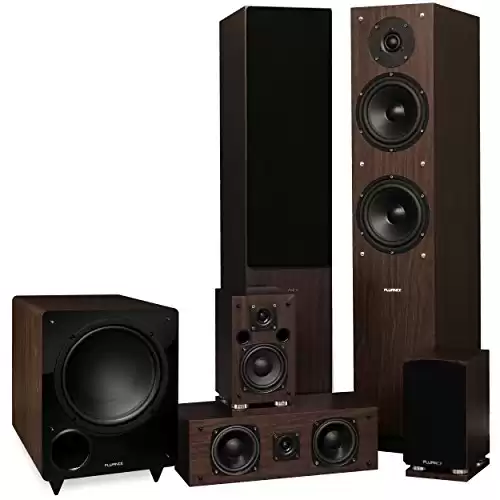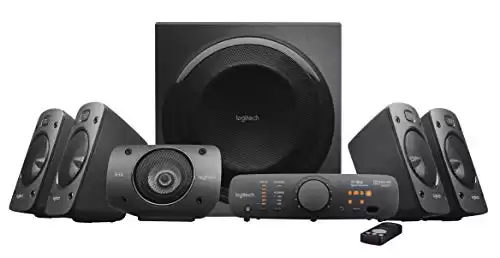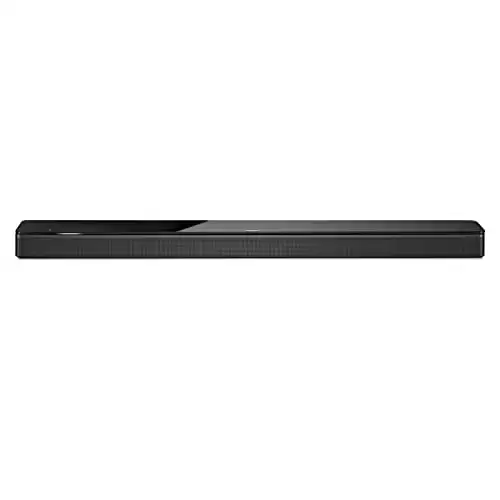Pulse-Code Modulation (PCM) and Bitstream are the two primary methods of sending audio from an input to a television or compatible computer.
Both options deliver roughly the same audio quality. The difference between the two involves how the setup on your device decodes the compressed sounds that get delivered to your outputs.
That means you’ll need to think about what options work best when setting up your home theater system.
As a general rule, most of the older equipment models work better with PCM. Your newer TVs and audio equipment benefit from the updated coding processes that Bitstream delivers.
PCM vs. Bitstream: Which Is Better?
The main difference between PCM and Bitstreem is that PCM is an algorithm that detects the compression coding to “unscramble” it for your audio equipment, whereas Bitstream is a binary sequence that converts the audio input into digital information. Both options provide a similar outcome, so your equipment dictates what to use.
If you set your television to the Bitstream option for audio input, you’ll receive compressed audio files to interpret. The receiver decodes this information to generate uncompressed output that you hear through your soundbar, TV speakers, or other equipment.
It’s the method that gets used to produce the surround sound formats when you have preamps, power amps, and processors working together to deliver realistic results.
High-end receivers even use a post-processing option that transitions the digital signal to analog for even more flexibility.
When you’re using Bitstream, your sound system is likely a Dolby Digital product. You can also use DTS technology with this option to maximize your audio settings.
If you select PCM, you’re using the entry-level standard for audio when watching TV, playing games, or listening to music.
It is essential to remember that this setting represents the HDMI audio format only when you choose your menu options. Bitstream is not a delivery format.
If you have Bitstream set as your HDMI audio format, you likely have Dolby Digital set as your output.
When PCM is your input setting, it is also typically your output setting.
That means you’d want to use PCM when your sound system has dual-channel supports only. You might also select PCM when the audio quality worsens with the Bitstream selection.
■ Is Bandwidth an Issue with PCM or Bitstream?
Since this choice represents your audio input, the bandwidth requirements come from the transmission source.
That means your cable company, satellite provider, or gaming console delivers the compressed audio files for distribution.
The one advantage you have involves Bitstream because it lets you support wired or wireless connections.
Although PCM works with wireless consoles and similar devices, it still requires a direct port for audio syncing.
That means Bitstream offers better choices for those with a home theater system.
It won’t work for your CD player, but that is why it is essential to review device compatibility before finalizing your system setup.
PCM vs. Bitstream: A Direct Comparison
When you consider PCM and Bitstream for your home theater experience, you’ll discover that each format delivers some specific pros and cons to consider.
It cannot be stressed enough that the average person will not detect a difference between these two HDMI audio inputs.
That’s because your television or receive translates those files into a usable output.
The one exception involves a setup that includes Dolby Digital beyond a 5.1 setting.
If you have more than five channels and a subwoofer as part of your equipment package, Bitstream might offer a slightly enhanced experience.
Most people will hear an output that is relatively the same, even when using different players to create results.
Here is a table comparing PCM and Bitstream:
| PCM | BITSTREAM | |
| COMPATIBILITY: | PCM offers compatibility with most of today’s available players, including Blu-ray, DVDs, and CD systems. | Bitstream works with most high-end players that provide surround sound formats. It does not offer support for CDs. |
| AUDIO FILES: | With PCM, the player converts an analog signal into digital, and in reverse when transmitting to the receiver. | This system encodes the audio files while following the specific formatting instructions provided for surround sound data and digital transmissions. |
| DECODING PROCESS: | When using PCM, the player decodes the audio files to transmit the information to the preferred receiver for the eventual output. | On Bitstream devices, the player transmits a compressed audio file to the receiver. This secondary system has the responsibility to decode the data for the output. |
| AUDIO OUTPUT: | PCM requires a higher bandwidth for its audio to prevent the quality from degrading because of the multiple conversions that occur. | Bitstream delivers more flexibility to receivers with this feature so that a high-quality audio output is always possible. |
| SECONDARY AUDIO: | With PCM, the structure provides support for a high-resolution secondary audio channel. It only uses a two-channel system, which means you still only get the left and right audio experience. | With Bitstream, the goal is to transmit a high-quality surround sound experience without the need for secondary audio. That’s why your options are somewhat limited in this comparison section. |
| TRANSMISSION: | PCM works with any device that supports digital and analog sound transmission. | Bitstream only works with devices that support digital sound transmission. There isn’t any analog support. |
| CONNECTIONS AND SUPPORTS: | With PCM, the support for coaxial or digital optical output is limited – and it might be non-existent for some home theater setups. | With Bitstream, users receive full support for coaxial and digital optical support, going up to five channels with a sixth that includes a subwoofer. |
When you have Dolby Digital 5.1 Surround Sound at home, you actually get six channels to support your audio experience.
The 0.1 part of that description represents the subwoofer that doesn’t always need to be on for your system.
What Happens When I Choose PCM?
Most people use an HDMI connection for their television input today. Although analog signals are still possible, even modern at-home antenna’s for free TV include high-definition support.
When you set your Blu-ray player, TV, or another HD input to PCM, it automatically decodes the file codecs sent by the transmission.
Every possible soundtrack from the system gets included with the delivery.
Once the decoding work is over, the device sends the uncompressed audio signal to the receiver.
Your receiver sends the signal to the connected speakers so that you can enjoy the output.
That means the PCM setup does all of the work automatically. You receive complete access to all audio types, including the descriptive formats that play for individuals with specific disabilities.
It also works for the supplementary audio tracks, commentaries, and anything else the transmission embeds into the compressed files.
Since Bitstream requires a separate setup to achieve that outcome, you might choose PCM as the better option when you need those features.
Where you’ll find limitations is when you have a coaxial or digital optical connection.
Since PCM only sends two channels for distribution, you’ll only get the left and right speaker benefits when listening.
You might find that it is incapable of handing high-resolution audio output when it decompresses the delivered files.
■ When to Use the PCM Configuration
There are four specific reasons when the PCM configuration makes sense for your audio setup.
- You want to unlock the high-quality secondary audio signal that accompanies the broadcast, disk, or stream you want to watch.
- You need a direct connection that offers a faster transmission to your output to remove latency.
- You must relieve the receiver of converting the audio information because the processing power isn’t high enough to deliver a successful result.
- You own a sound system that prefers having the audio files decoded at the player instead of the receiver.
Although these reasons can give you some specific advantages, it doesn’t mean that the final audio quality you hear is any better than a Bitstream configuration.
The primary difference involves the channels. With PCM, the audio plays in the left and right track only to deliver audio movement.
It’s the standard setup that a majority of homes use to manage their entertainment system.
You can even use PCM when you have multiple channels installed. The only difference is that you won’t get two on the left and right with a single one in the center.
Since PCM works with virtually every player and device, you’ll have an almost guaranteed audio solution.
Although it isn’t lossless or smooth in some situations, it delivers a consistent result that performs well on all but the most sophisticated of today’s sound systems.
What Happens When I Select Bitstream?
When you turn your TV menu setting to the Bitstream option, your device bypasses all of its decoders.
Your signal transmits the audio to the receiver instead of decompressing the files locally.
It helps to think about it like this. If you set your TV to PCM, the PS5 you got for the holidays will decode the information at the console before sending the audio files for output. When you have it on the Bitstream setting, the decoding work happens at the TV instead.
If you have a cable or satellite box that receives Bitstream, this device might decode the information before sending it to the television for distribution.
This structure benefits the advanced home theater systems that use Dolby Atmos® or previous generations because the compressed file requires less bandwidth during the initial transmission.
If you send one folder of compressed files instead of 2,000 individual files individually uploaded, it’s much easier for your entertainment center to manage the information.
Although this structure works well for most systems, it can be problematic if your setup relies on a secondary audio setting.
You’ll receive a downgrade in the delivered audio because your receiver will always select the lowest distribution option.
If you have DTS-HD or Dolby TrueHD® to use at home, a program relying on secondary audio will cause you to receive Dolby Digital or DTS instead because it must use both file structures in the same bandwidth.
That means anyone using Bitstream should be careful about anything that uses high-resolution secondary audio.
The performance always gets limited to the standard definition audio when delivered to your preferred output.
■ When to Use the Bitstream Configuration
It would be best to use the Bitstream configuration for your home entertainment system when encountering these four scenarios.
- Your goal is to take advantage of the 5.1-channel supports that your audio system can use with a coaxial or digital optical connection.
- You need to provide your sound system with more flexibility when it plays high-resolution audio on the primary channel.
- You want to include a receiver with more processing power in your home entertainment system.
- Your sound system relies on the receiver to decompressed and process the audio files that eventually get sent to the output.
Although you’ll receive a standard audio result when using Bitstream for options that rely on the secondary audio feed, that’s a minor compromise to make for all of the other benefits that come with this setup.
You receive better audio output with Bitstream because the compressed files take up less bandwidth.
That means more information gets sent to your output eventually, allowing you to put more speakers into your home entertainment system.
It also provides the option to deliver a wireless option that lets you take advantage of the high-end receivers and their improved processing capabilities.
If you’re only using an entry-level sound system, you won’t notice much of a difference with the output. That means you’ll need to invest in one of today’s best products before you’ll get a noticeable difference.
Best Sound Systems to Use with Bitstream Today
If you’re ready to step up to a better audio experience, it is time to get a surround sound home speaker system that can handle more than two channels.
These investments are the ones that make the most sense today because of each product’s proven capabilities.
1. Fluance Elite Series Sound Home Theater System
This product delivers a 5.1 speaker system with a matched timbre to offer a powerful and crisp audio experience.
When you watch movies or TV shows with this equipment, it’ll feel like a real-life experience. If you hear a CD from a compatible file, you’ll get the frequencies in your ear in the way that the artist intended.
Instead of offering a low-profile system, you’ll receive three-way floor-standing towers with the Fluance Elite Series system.
It gives you a dynamic midrange, stunning high frequencies, and rumbling lows that make the floor vibrate. The system naturally suppresses distortion to ensure you receive a genuine cinematic experience.
2. Logitech Z906 5.1 Surround Sound System
If you need a low-profile surround sound system for your entertainment center, this design delivers an excellent result for a competitive price.
You’ll receive THX-certified products with this investment, which uses a wall-mounted design to help you reduce the floor footprint.
It delivers up to 500w of continuous power, with peaks of up to 1,000w in certain situations. The bass is something that you’ll feel, and you can connect up to six devices.
When you want to maximize the use of the Logitech Z906, the sound controls let you personalize the experience you receive from the Bitstream settings.
You can hear each detail in the way you prefer, including DTS and Dolby Digital soundtracks. The primary complaint about this system is its durability, which means you shouldn’t keep it at full volume every time it gets used.
3. Bose Soundbar 700
If space is limited for your home entertainment system, you need a single product that can deliver the multi-channel support you want.
With this system, you’ll get two-floor speakers and a soundbar that provides some of the best audio performances you’ve ever heard with an at-home system.
When you have an equipped Amazon device, you can use Alexa voice controls to manage the system.
The Bose Soundbar 700 with speakers delivers an authentic movie theater sound for a reasonable price.
You won’t believe the quality that you receive with this investment. Although the setup is a little complicated, you’ll have everything up and running in a couple of hours for most systems.
PCM vs. Bitstream: A Final Thought
If you compare the output that PCM and Bitstream offer to most households, there isn’t a clear winner. You should select the option that works better for your equipment.
Your choice ultimately depends on the sound configuration you want. Are you satisfied with only two channels, or do you prefer to have more?
Although PCM is better from a secondary audio standpoint, Bitstream delivers a more sophisticated result through its transmission method.
It lets you take advantage of the better codecs so that you receive an impressive listening experience.





